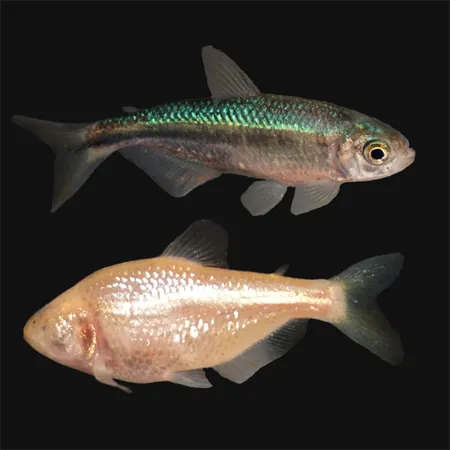
The Incredible Evolution of Cavefish: How They Lost Their Eyes and Gained Survival Skills
2025-08-25
Author: Kai
The Mysterious Case of Eye-less Cavefish
Time after time, cavefish populations trapped in their dark homes have undergone a startling transformation: they lost their eyesight. But don't be fooled—these fascinating creatures didn't simply suffer losses; they also evolved remarkable new traits that helped them adapt to life in the shadows, revealing potential clues to human health issues like obesity and diabetes.
Why Did Their Eyes Disappear?
For years, scientists puzzled over why cavefish lost their eyes. Some believed their diminished vision was a result of no longer needing them—after all, with little light to navigate, faulty eyes wouldn’t hinder survival. However, evolutionary physiologist Nicolas Rohner now suggests a more compelling reason: eyes are a costly biological feature that demands substantial energy.
Unique Genetic Mutations
Research indicates that various genetic mutations have independently contributed to eye loss in different cavefish populations. This shows not only that they evolved without sight but also that they enhanced their other senses significantly. Remarkably, cavefish possess a heightened ability to detect low amino acid levels compared to their surface counterparts, along with a greater number of taste buds and sensory cells.
The Eye Development Mystery
Embryonically, cavefish start the eye development process just like their surface relatives. Yet, after a short while, these eye cells begin to die off, disappearing entirely. Developmental biologist Misty Riddle hypothesizes that this pattern may be due to the intertwined evolution of the brain and eyes; altering the eye program might be key to boosting other sensory capabilities.
Starvation and Overeating: The Cavefish Diet Dilemma
Given their nutrient-scarce environment, one can understand why cavefish don't waste energy maintaining unused eyes. They often survive on a meager diet primarily composed of bat droppings and organic debris washed into their caves. Remarkably, studies reveal these fish possess mutations linked to diabetes and obesity in humans, but in cavefish, these traits serve beneficial purposes.
The Curious Case of Carotenoids
When cavefish do find food, they gorge themselves, leading to surprising phenomena: their fats, which can appear bright yellow due to carotenoids, are linked to their absence of eyes. As Riddle points out, unlike their surface counterparts, there's no connection between eye presence and carotenoid accumulation in their fat cells. Instead, these pigments may help mitigate inflammation, crucial for a species that experiences fluctuating food availability.
Insights into Health and Longevity
Further research reveals cavefish produce lower levels of inflammatory cytokines and reactive oxygen species, hinting at how they can stay healthy despite their unorthodox diet. As Krishnan delves deeper into this area, the scientific community's attention is increasingly focused on the unique mechanisms that allow cavefish to thrive even in starvation.
Conservation: Why It Matters
Despite the advancements in understanding cavefish biology, the broader question remains: why did the Mexican tetra evolve uniquely into cave-dwelling forms while other river fish did not? With only a few cavefish species in existence compared to their surface relatives, it's crucial to conserve their populations, particularly as they are vulnerable to pollution and water extraction.
Joint efforts in conservation and research are underway, with students like David Perez Guerra actively supporting cavefish preservation initiatives. As researchers tread carefully to utilize cavefish in their studies without causing waste, the lessons we learn from these extraordinary creatures continue to hold immense potential for medical and ecological applications.




 Brasil (PT)
Brasil (PT)
 Canada (EN)
Canada (EN)
 Chile (ES)
Chile (ES)
 Česko (CS)
Česko (CS)
 대한민국 (KO)
대한민국 (KO)
 España (ES)
España (ES)
 France (FR)
France (FR)
 Hong Kong (EN)
Hong Kong (EN)
 Italia (IT)
Italia (IT)
 日本 (JA)
日本 (JA)
 Magyarország (HU)
Magyarország (HU)
 Norge (NO)
Norge (NO)
 Polska (PL)
Polska (PL)
 Schweiz (DE)
Schweiz (DE)
 Singapore (EN)
Singapore (EN)
 Sverige (SV)
Sverige (SV)
 Suomi (FI)
Suomi (FI)
 Türkiye (TR)
Türkiye (TR)
 الإمارات العربية المتحدة (AR)
الإمارات العربية المتحدة (AR)